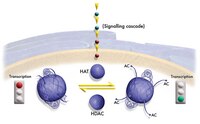12-358 Sigma-AldrichAcetyl-Histone H3 (Lys9) Peptide
Routinely evaluated in a Dot Blot Assay by spotting on nitrocellulose & detecting by using a Anti-acetyl Histone H3 (Lys9) (06-942).
More>> Routinely evaluated in a Dot Blot Assay by spotting on nitrocellulose & detecting by using a Anti-acetyl Histone H3 (Lys9) (06-942). Less<<Recommended Products
Overview
| Replacement Information |
|---|
Key Specifications Table
| Key Applications | Entrez Gene Number | Modifications | Uni Prot Number |
|---|---|---|---|
| WB | NM_002107.3 | Acetylation | Q16695 |
| Description | |
|---|---|
| Catalogue Number | 12-358 |
| Brand Family | Upstate |
| Trade Name |
|
| Description | Acetyl-Histone H3 (Lys9) Peptide |
| References |
|---|
| Product Information | |
|---|---|
| Presentation | Lyophilized powder |
| Quality Level | MQ100 |
| Applications | |
|---|---|
| Application | Routinely evaluated in a Dot Blot Assay by spotting on nitrocellulose & detecting by using a Anti-acetyl Histone H3 (Lys9) (06-942). |
| Key Applications |
|
| Physicochemical Information |
|---|
| Dimensions |
|---|
| Materials Information |
|---|
| Toxicological Information |
|---|
| Safety Information according to GHS |
|---|
| Safety Information |
|---|
| Storage and Shipping Information | |
|---|---|
| Storage Conditions | 2 years at -20°C |
| Packaging Information | |
|---|---|
| Material Size | 100 µg |
| Transport Information |
|---|
| Supplemental Information |
|---|
| Specifications |
|---|
| Global Trade Item Number | |
|---|---|
| Catalog Number | GTIN |
| 12-358 | 04053252477591 |
Documentation
Acetyl-Histone H3 (Lys9) Peptide SDS
| Title |
|---|
Acetyl-Histone H3 (Lys9) Peptide Certificates of Analysis
| Title | Lot Number |
|---|---|
| Acetyl-Histone H3 (Lys9) Peptide - 18692 | 18692 |
| Acetyl-Histone H3 (Lys9) Peptide - 23085 | 23085 |
| Histone H3 (Ac Lys9) Peptide (residues 1-12) - 2370139 | 2370139 |
| Histone H3 (Ac Lys9) Peptide - 1990172 | 1990172 |
| Histone H3 (Ac Lys9) Peptide - 3494921 | 3494921 |
| Histone H3 (Ac Lys9) Peptide - 4145781 | 4145781 |
| Histone H3 (Ac Lys9) Peptide - 4146074 | 4146074 |
| Histone H3 (Ac Lys9) Peptide -2800511 | 2800511 |
References
| Reference overview | Pub Med ID |
|---|---|
| West Nile virus activity--United States, September 8-14, 2004. Morbidity and mortality weekly report MMWR. Morbidity and mortality weekly report 53 2004 Show Abstract | 15371969
 |









